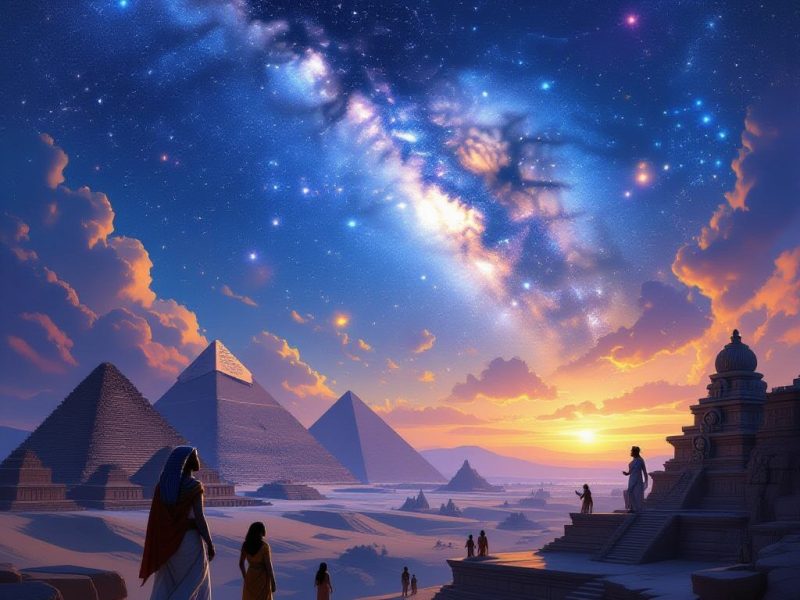Introduction: When the Sky Was Scripture
Before telescopes and satellites, before Google Maps of galaxies and deep-space radio signals, there were stories—myths etched into the sky with stars as ink and the imagination as a compass. Our ancestors looked upward not just for weather forecasts but for purpose, identity, and divine whispers.
The Sky as Mythical Canvas
Almost every ancient civilization—from the Sumerians to the Incas—developed a cosmology interwoven with celestial phenomena. The Greeks saw gods and monsters in the sky: Orion the hunter, Andromeda the chained maiden, and Hydra the serpentine terror. But beyond the poetic allure, these constellations were calendar markers and celestial coordinates guiding agriculture, seafaring, and ritual.
Starlore from Around the World
India: The Nakshatras (lunar mansions) are a set of 27 or 28 asterisms referenced in the Vedas, and they play a central role in Jyotisha (Vedic astrology). Each star cluster is associated with a deity, a myth, and a cosmic function.
Mayan Civilization: The Mayans tracked Venus more obsessively than we track stock prices today. Venus was linked to war and divination. Their Dresden Codex includes remarkably accurate planetary calculations.
China: Ancient Chinese astronomy divided the sky into “Four Symbols”—the Azure Dragon, Vermilion Bird, White Tiger, and Black Tortoise—each corresponding to a cardinal direction and season.
Star Maps as Spiritual Maps
What if the ancient maps of the sky were also maps of the soul? Some esoteric traditions assert that constellations are energetic blueprints. For instance, the Hermetic principle “As above, so below” suggests that the macrocosm (universe) and microcosm (human) mirror each other.
Egyptians aligned pyramids with Orion’s Belt. The Hopi aligned their settlements with the Pleiades. Why? Perhaps they believed cosmic harmony was the foundation of earthly harmony.
Myth Meets Modern Science
Fast forward to the 21st century, and astrophysicists are discovering structures so vast they make ancient myths look eerily prophetic. Take the Sloan Great Wall, a massive cosmic filament of galaxies stretching over a billion light-years. Or the Hercules–Corona Borealis Great Wall, the largest known structure in the universe.
Some theorists suggest ancient myths were not fictional tales but encoded knowledge—transmissions from advanced civilizations or cosmic intelligences who knew the universal layout.
The Zodiac and Precession of the Equinoxes
The twelve zodiac signs are more than mere symbols for horoscopes; they are part of a cosmic calendar affected by the Earth’s 26,000-year wobble—known as the precession of the equinoxes. This cycle aligns with mythic ages such as the Age of Aquarius, each believed to bring collective shifts in consciousness.
Astrophysics Confirms the Ancients?
Here’s where it gets mind-bending. Some cosmologists now propose that consciousness may play a role in the fabric of reality. Quantum entanglement, dark matter, and energy fields align curiously with mystical concepts like the Akashic Records, chi, or the Hindu concept of Brahman (universal consciousness).
Was ancient myth a poetic language for what we now understand as quantum phenomena?
Decoding the Celestial Blueprint
What if constellations are not merely stars but archetypal imprints? Carl Jung’s theory of the collective unconscious suggests that myths are expressions of shared human experiences. Perhaps when we mapped constellations, we were mapping our inner psyche across the cosmos.
This theory is explored in works like Hamlet’s Mill and the writings of Mircea Eliade, who connect mythology to astronomical knowledge buried in symbolic language.
Modern Implications and the Future of Cosmic Mythology
As space travel becomes plausible and AI deciphers ancient scripts, we may find that the myths we once dismissed as fantasy are star maps pointing to our future. Just as ancient star myths inspired cities, temples, and moral codes, the rediscovery of cosmic starlore may inspire ethical paradigms for the interstellar age.
Conclusion: The Stars Are Still Speaking
In the end, whether we view constellations through the lens of science or myth, they connect us to something greater than ourselves. They remind us that we are part of a narrative that spans galaxies and epochs—a starlit story still unfolding.
So next time you gaze up at Orion, know that you’re not just looking at stars. You’re reading the oldest scripture written not on paper, but in photons, soul, and stardust.


